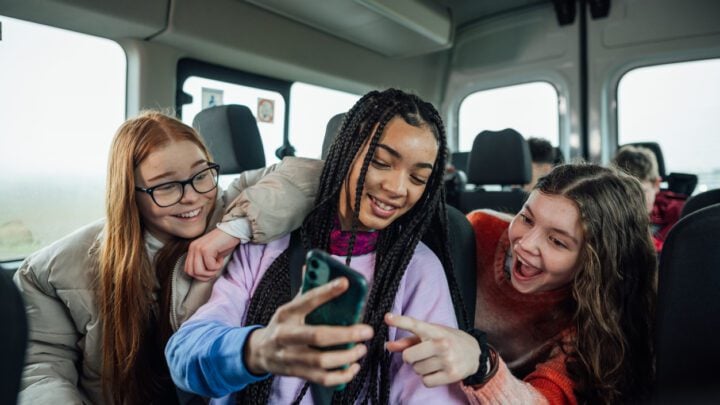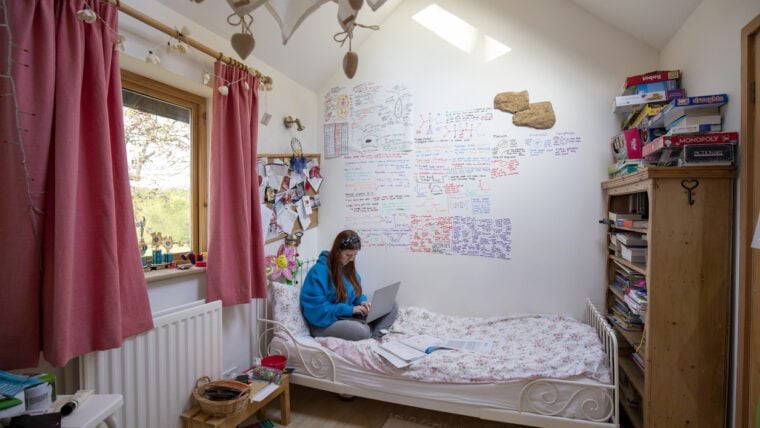- Introduction and methodology
- Glossary of terms
- Digital technologies in young people’s lives: Access and time use
- Relationships
- Identity
- Well-being
- Conclusion
Introduction
Digital technologies form part of the everyday for many people in the UK. They intersect with how we work, learn, stay connected, organise our lives and participate in society. Where once digital life was considered a separate experience from someone’s non-digital life, we find ourselves in a time where the two modalities are tangled together.
This data commentary explores, through available research, how young people are living and connecting in online spaces. It sits within the Nuffield Foundation’s wider Grown up?[ref]Nuffield Foundation (2025). Grown up? Journeys to Adulthood. Available from: https://www.nuffieldfoundation.org/research/our-programmes/grown-up [Accessed 20 June 2025]. [/ref] programme of research, which examines the realities of becoming an adult across four interconnected areas for young people today: pathways to independence; education to work; digital lives; and mental health and well-being.
This commentary is one of a series of publications examining the experiences of young people growing up with digital technologies, drawing on new analysis of existing datasets and evaluating quantitative evidence on this topic. It serves as a starting point for the subsequent publications, which will use qualitative methods to explore themes from this synthesis, and others that emerge from our discussions with young people, in more depth and nuance. This multi-methods approach comes from a recognition that digital technologies are rapidly changing and quantitative methods, particularly large-scale surveys, can take a lot of time from research design through to fieldwork, reporting, and making datasets publicly available for reuse, during which the digital technologies people interact with can change significantly. A lot of data on how young people are engaging with technologies also sits in the private sector, often limiting the availability of data on this topic.
At the same time, the concept of growing up can be difficult to define. Here, qualitative methods offer opportunities for co-creation with young people themselves in setting the parameters for the scope of study, ensuring research reflects lived experiences and resonates with their hopes, concerns and priorities.
Rethinking journeys to adulthood: An introduction highlights that the experience of growing up may be different or unique for 14–24-year-olds in the UK today, as the first generation to be entirely born in the digital age[ref]Batcheler, R., Oppenheim, C, and Sarygulov, A. (2025). Rethinking Journeys to Adulthood: An Introduction. Nuffield Foundation. Available from: https://www.nuffieldfoundation.org/wp-content/uploads/2025/04/DC1-Rethinking-journeys-to-adulthood-29.4.pdf. [/ref],[ref]Lucas, O., Vallgarda, L.M., and Steen, B. (2024). Society Watch 2024: Understanding the New Generation of Voters. National Centre for Social Research. Available from: https://natcen.ac.uk/sites/default/files/2024-05/Society%20Watch%202024.pdf. [/ref]. Perhaps for this reason, digital technologies are at the centre of both policy and public discourses in relation to young people.
From a policy perspective, digital skills, digital inclusion and digital safety have been at the forefront of guidance in the shaping of young people’s digital lives. In 2024, the current government launched its review of the national curriculum in England, which, among other things, is looking to determine the key digital skills needed in the journey to adulthood, to ensure young people are resilient to misinformation and extremist content online[ref]Department for Education (2025). Curriculum and Assessment Review: Interim Report. Available from: https://www.gov.uk/government/publications/curriculum-and-assessment-review-interim-report. [/ref]. Improving access to digital technologies is also a priority for the government[ref]Department for Science, Innovation & Technology (2025). Digital Inclusion Action Plan: First Steps. Accessed 6 June 2025. Available from: https://assets.publishing.service.gov.uk/media/67bdc3edb0d253f92e213c47/digital_inclusion_action_plan_first_steps.pdf. [/ref], recognising that digital inequalities can have detrimental impacts on children’s participation in education and communications with family and friends. In response to evidence on the risks that online spaces can pose to young people, the Online Safety Act 2023 requires digital platforms and services to assess any risks to children from using their products, requiring stronger age restrictions to protect young people from harmful content[ref]Department for Science, Innovation and Technology (2025). Online Safety Act: Explainer. Available from: https://www.gov.uk/government/publications/online-safety-act-explainer/online-safety-act-explainer. [/ref].
Public discourse tends to be focused on the harms of digital technologies. These include narratives around addiction, online platforms exposing young people to harmful content, and digital devices leading to detriments to physical and emotional well-being[ref]Vardy, E. (2024). Adults and Teens Pick Dumbphones to Curb Social Media Addiction. BBC News. Available from: https://www.bbc.com/news/articles/c7227njm45eo. [/ref],[ref]BBC News (2025). TikTok, Instagram, Facebook, Youtube – Parents and Teachers’ Warning amid ‘upsetting’ Posts. Available from: https://www.bbc.co.uk/news/live/clygjdj42p1t [Accessed 14 July 2025]. [/ref],[ref]Peckham, K. (2025). Children Are Starting School Unable to Sit up or Hold a Pencil – and I Know the Culprit. The Guardian. Available from: https://www.theguardian.com/commentisfree/2025/feb/18/children-school-screen-time-early-years-specialist-smartphones-physical-activity. [/ref]. There are ongoing debates around whether or not smartphones (mobile phones with advanced computing capabilities and the ability to connect to the internet) should be banned in schools and the extent to which such policies should be mandated by government[ref]Shearing, H. (2025). Leave Phone Bans to Head Teachers, Children’s Commissioner Says. BBC News. Available from: https://www.bbc.com/news/articles/cly11270npeo. [/ref],[ref]Evans, A. (2025). Phone Bans in Schools Don’t Help Grades or Health, Study Suggests. BBC News. Available from: https://www.bbc.com/news/articles/cy8plvqv60lo. [/ref],[ref]Boucher, H. (2025). Ban Smartphones in Schools, Starmer Told – by the Country That’s Done It. The Independent. Available from: https://www.independent.co.uk/news/uk/politics/smartphone-ban-schools-starmer-new-zealand-b2758775.html. [/ref]. News stories and influential literature around the negative impacts of smartphones and social media on young people’s well-being have also led to calls for bans on social media use for under-16s[ref]Internet Matters (2025). Connected and Conflicted: Children’s Perspectives on Restricting Social Media for under-16s. Available from: https://www.internetmatters.org/hub/research/childrens-perspectives-on-restricting-social-media-for-under-16s/. [/ref].
Campaign groups like Smartphone Free Childhood take a less regulatory stance and are advocating for parents to delay rather than ban their children’s access to smartphones and social media, arguing that these technologies are not designed with young people in mind and lead to measurable and mounting risks[ref]Smartphone Free Childhood (n.d.). Homepage. Available from: https://www.smartphonefreechildhood.org/ [Accessed 20 June 2025]. [/ref]. The role of parents and carers in supporting, protecting, and managing their older children’s/teenagers’ online experiences and risks (especially for those under 18) is a major and important topic in its own right and we touch on it only briefly (see forthcoming expert commentary by ParentZone and Voice Box), as our principal focus here is on young people themselves.
Youth engagement has a critical role to play in the shaping of narratives and policy around digital technologies and the ways they affect experiences of growing up. This data commentary is a first step in a process to provide an up-to-date picture of young people’s experiences with digital technologies. Further insight will follow in Digital Lives Workshop Findings (forthcoming) and new qualitative research which is underway[ref]Nuffield Foundation (2025). Grown up? Journeys to Adulthood. Available from: https://www.nuffieldfoundation.org/research/our-programmes/grown-up [Accessed 20 June 2025]. [/ref].
Using available data from young people’s attitudes surveys, this data commentary synthesises overarching themes in relation to the role of digital technologies in young people’s journeys to adulthood. We also embed reflections on the data available from our Youth Insight Group of 14–24-year-olds[ref]Youth engagement forms a core element of the Grown up? programme. The Nuffield Foundation has commissioned Hopkins Van Mil to undertake a programme of youth engagement which includes two elements: the Youth Insight Group (YIG) and deep dive workshops. The YIG comprises 20 young people aged 14–24 from all four nations of the UK and from a diverse range of backgrounds. It meets nine times over the course of the project. The eight deep dives draw on different groups of young people across the UK to explore three topics: education to work, digital lives and mental health. [/ref]. This is a cohort of 20 young people from across the UK who have been a core advisory group for the Grown up? project. Using the available data and reflections from the Youth Insight Group, we make recommendations for further areas of research in this field.
While primarily focused on data from the UK, this commentary considers evidence from other western English-speaking countries – often the United States – that may be comparable to the UK. We are guided by the following research questions:
- What do quantitative data sources tell us about the level of access 14–24-year-olds have to digital technologies, how much time they spend with these technologies, and what they are doing with this time?
- How do digital technologies relate to experiences of ‘growing up’, focusing on young people’s:
- Relationships with others
- Individual identity formation
- Mental health and well-being
- Exposure to online harms.
- How do members of our Youth Insight Group respond to, and recognise, overarching patterns in the available data about young people and their digital lives?
These research questions emerged from an initial literature review and team consultations on the broad topic of growing up and digital technologies. From this process we established that we were primarily interested in psychosocial dimensions of growing up, reflecting on the prominence of policy dilemmas and public discourse on this topic, and the limited nature of Nuffield Foundation-funded research in this territory.
Methodology
Desk-based research
To understand how digital technologies relate to the experiences of 14–24-year-olds, we conducted a ‘hermeneutic literature review’[ref]Boell, S.K., and Cecez-Kecmanovic, D. (2010). Literature Reviews and the Hermeneutic Circle. Australian Academic & Research Libraries 41. 129–44. Available from: https://doi.org/10.1080/00048623.2010.10721450. [/ref], allowing the research team to collaboratively iterate the literature search and synthesis process. The literature reviewed included peer-reviewed research as well as wider grey research (not from academic or commercial publishers)and media coverage of issues around young people and digital life.
The following themes emerged from this review, which we focused the remainder of our desk-based research on, and which formed the basis for our research questions.
The role of digital technologies on young people’s:
- Time use
- Relationships with others
- Individual identity formation
- Mental health and well-being
- Exposure to online harms.
These themes do not explore explicit markers or milestones in the journey to adulthood. We felt participatory research methods with young people would be more appropriate for doing that, as these markers and milestones would need to resonate with young people.
We then narrowed our inclusion criteria to prioritise large-scale surveys (for example, over 1,000 respondents) with young people across our age bracket of interest (14–24). We have used available data to cover the entire span of this age group, but where that is not possible, we have focused on part of the relevant age span. Most of this research is based on the attitudes of young people in the UK. Where comparable research is not available, we reference sources from other English-speaking western nations.
Secondary data analysis
This data commentary also features secondary analysis of existing datasets. We use the latest 2022 dataset from the Understanding Society[ref]University of Essex, Institute for Social and Economic Research (2024). Understanding Society: Calendar Year Dataset, 2022 [data collection]. Available from: http://doi.org/10.5255/UKDA-SN-9333-1. [/ref] longitudinal household study, and the 2025 How do people feel about AI?[ref]Modhvadia, R., et al. (2025). How Do People Feel about AI? Wave 2 (2025). Ada Lovelace Institute, The Alan Turing Institute. Available from: https://attitudestoai.uk/about-the-survey/citation-and-pdf. [/ref] dataset. These were chosen because of their relevance to our research interests, their coverage of the age range central to this study, and their robust research design. Across these datasets, we analyse descriptive statistics relating to 14–24-year-olds.
Youth Insight Group
Emergent findings from the desk-based research were presented to the programme’s Youth Insight Group (see Appendix 1). Reflections from the group are included and inform our recommendations for further areas of study. In this commentary we summarise discussions from the group that relate to the themes we explored in our desk-research. Summaries draw from collaborative discussions with the team and reflections from our research partner, Hopkins Van Mil.

